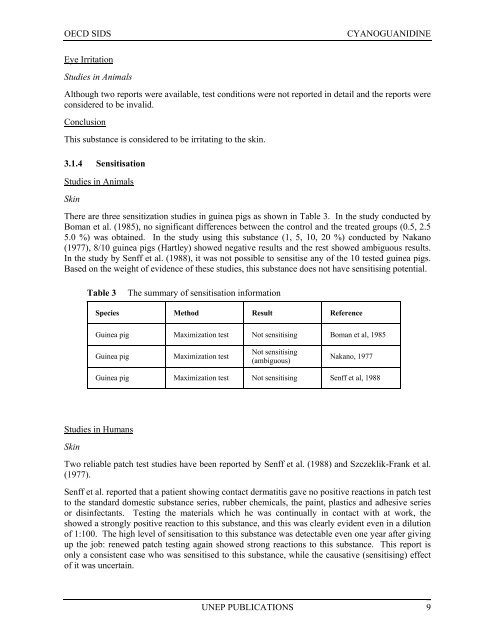Cyanoguanidine CAS N°: 461-58-5
Cyanoguanidine CAS N°: 461-58-5
Cyanoguanidine CAS N°: 461-58-5
You also want an ePaper? Increase the reach of your titles
YUMPU automatically turns print PDFs into web optimized ePapers that Google loves.
OECD SIDS<br />
CYANOGUANIDINE<br />
Eye Irritation<br />
Studies in Animals<br />
Although two reports were available, test conditions were not reported in detail and the reports were<br />
considered to be invalid.<br />
Conclusion<br />
This substance is considered to be irritating to the skin.<br />
3.1.4 Sensitisation<br />
Studies in Animals<br />
Skin<br />
There are three sensitization studies in guinea pigs as shown in Table 3. In the study conducted by<br />
Boman et al. (1985), no significant differences between the control and the treated groups (0.5, 2.5<br />
5.0 %) was obtained. In the study using this substance (1, 5, 10, 20 %) conducted by Nakano<br />
(1977), 8/10 guinea pigs (Hartley) showed negative results and the rest showed ambiguous results.<br />
In the study by Senff et al. (1988), it was not possible to sensitise any of the 10 tested guinea pigs.<br />
Based on the weight of evidence of these studies, this substance does not have sensitising potential.<br />
Table 3<br />
The summary of sensitisation information<br />
Species Method Result Reference<br />
Guinea pig Maximization test Not sensitising Boman et al, 1985<br />
Guinea pig<br />
Maximization test<br />
Not sensitising<br />
(ambiguous)<br />
Nakano, 1977<br />
Guinea pig Maximization test Not sensitising Senff et al, 1988<br />
Studies in Humans<br />
Skin<br />
Two reliable patch test studies have been reported by Senff et al. (1988) and Szczeklik-Frank et al.<br />
(1977).<br />
Senff et al. reported that a patient showing contact dermatitis gave no positive reactions in patch test<br />
to the standard domestic substance series, rubber chemicals, the paint, plastics and adhesive series<br />
or disinfectants. Testing the materials which he was continually in contact with at work, the<br />
showed a strongly positive reaction to this substance, and this was clearly evident even in a dilution<br />
of 1:100. The high level of sensitisation to this substance was detectable even one year after giving<br />
up the job: renewed patch testing again showed strong reactions to this substance. This report is<br />
only a consistent case who was sensitised to this substance, while the causative (sensitising) effect<br />
of it was uncertain.<br />
UNEP PUBLICATIONS 9
















